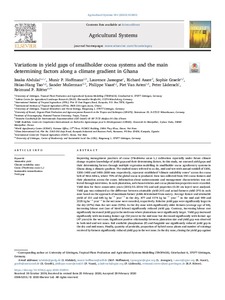| dc.contributor.author | Abdulai, I. |
| dc.contributor.author | Hoffmann, M.P. |
| dc.contributor.author | Jassogne, L. |
| dc.contributor.author | Asare, R. |
| dc.contributor.author | Graefe, S. |
| dc.contributor.author | Tao, H.H. |
| dc.contributor.author | Muilerman, S. |
| dc.contributor.author | Vaast, P. |
| dc.contributor.author | van Asten, P. |
| dc.contributor.author | Laderach, P. |
| dc.contributor.author | Rötter, R.P. |
| dc.date.accessioned | 2020-08-06T11:47:00Z |
| dc.date.available | 2020-08-06T11:47:00Z |
| dc.date.issued | 2020 |
| dc.identifier.citation | Abdulai, I., Hoffmann, M.P., Jassogne, L., Asare, R., Graefe, S., Tao, H.H., ... & Rötter, R.P. (2020). Variations in yield gaps of smallholder cocoa systems and the main determining factors along a climate gradient in Ghana. Agricultural Systems, 181, 1-8. |
| dc.identifier.issn | 0308-521X |
| dc.identifier.uri | https://hdl.handle.net/20.500.12478/6914 |
| dc.description.abstract | Improving management practices of cocoa (Theobroma cacao L.) cultivation especially under future climate change requires knowledge of yield gaps and their determining factors. In this study, we assessed yield gaps and their determining factors through multiple regression modelling in smallholder cocoa agroforestry systems in Ghana along a climatic gradient. The studied zones referred to as dry, mid and wet with annual rainfall of 1200, 1200–1400 and 1400–2000 mm respectively, represent established “climate suitability zones” across the cocoa belt of West Africa, where 70% of the global cocoa is produced. Data was collected from 150 cocoa farmers and their plantation across the zones. Information about socioeconomic and management characteristics was collected through interviews. In each plantation, soil characteristics and cocoa plantation properties were recorded. Yield data for three consecutive years (2012/13–2014/15) and soil properties (0–30 cm layer) were analysed. Yield gap was estimated as the difference between attainable yield (AY) and actual farmers yield (FY) in each zone based on the approach of maximum farmer yields determined from survey. Average farmer and attainable yield of 211 and 645 kg ha−1 year−1 in the dry, 477 and 1174 kg ha−1 year−1 in the mid and 999 and 2125 kg ha−1 year−1 in the wet zone were recorded, respectively. Relative yield gaps were significantly larger in the dry (67%) than the wet zone (53%). In the dry zone with significantly older farmers (average age of 64), increasing labour cost (use of hired labour) significantly reduced yield gap. Contrary, increasing labour cost significantly increased yield gap in the mid zone where plantations were significantly larger. Yield gap increased significantly with increasing farmer age (54 years) in the mid zone but decreased significantly with farmer age (47 years) in the wet zone. Significant positive relationship between plantation size and yield gap was observed in both mid and wet zones. Soil available phosphorous (P) and fungicide use significantly reduced yield gap in the dry and mid zones. Finally, quantity of pesticide, proportion of hybrid cocoa plants and number of trainings received by farmers significantly reduced yield gap in the wet zone. In the dry zone, closing the yield gap against the climate risk might be unlikely. Transformation into more drought resistant systems such as cashew might be promising. However, in the mid and wet zones, labour availability for effective management of large plantations might be the major barrier for intensification, which needs to be addressed by intervention strategies. |
| dc.description.sponsorship | German Federal Ministry for Economic Cooperation and Development |
| dc.format.extent | 1-8 |
| dc.language.iso | en |
| dc.subject | Theobroma Cacao |
| dc.subject | Yield Gap |
| dc.subject | Yield Factors |
| dc.subject | Climate Change |
| dc.subject | Smallholders |
| dc.subject | Intensification |
| dc.title | Variations in yield gaps of smallholder cocoa systems and the main determining factors along a climate gradient in Ghana |
| dc.type | Journal Article |
| cg.contributor.crp | Climate Change, Agriculture and Food Security |
| cg.contributor.affiliation | University of Göttingen |
| cg.contributor.affiliation | Leibniz Centre for Agricultural Landscape Research |
| cg.contributor.affiliation | International Institute of Tropical Agriculture |
| cg.contributor.affiliation | University of Kassel |
| cg.contributor.affiliation | National Taiwan University |
| cg.contributor.affiliation | Deutsche Gesellschaft für Internationale Zusammenarbeit |
| cg.contributor.affiliation | Université de Montpellier |
| cg.contributor.affiliation | World Agroforestry Centre |
| cg.contributor.affiliation | Olam International Ltd., Uganda |
| cg.contributor.affiliation | International Center for Tropical Agriculture |
| cg.coverage.region | Africa |
| cg.coverage.region | West Africa |
| cg.coverage.country | Ghana |
| cg.coverage.hub | Headquarters and Western Africa Hub |
| cg.researchtheme | Natural Resource Management |
| cg.identifier.bibtexciteid | ABDULAI:2020 |
| cg.isijournal | ISI Journal |
| cg.authorship.types | CGIAR and developing country institute |
| cg.iitasubject | Agronomy |
| cg.iitasubject | Climate Change |
| cg.iitasubject | Cocoa |
| cg.iitasubject | Plant Production |
| cg.iitasubject | Smallholder Farmers |
| cg.journal | Agricultural Systems |
| cg.notes | Published online: 6 Mar 2020 |
| cg.accessibilitystatus | Limited Access |
| cg.reviewstatus | Peer Review |
| cg.usagerightslicense | Copyrighted; all rights reserved |
| cg.targetaudience | Scientists |
| cg.identifier.doi | https://dx.doi.org/10.1016/j.agsy.2020.102812 |
| cg.iitaauthor.identifier | Laurence Jassogne: 0000-0002-2106-5001 |
| cg.iitaauthor.identifier | Richard Asare: 0000-0001-6798-7821 |
| cg.iitaauthor.identifier | Piet van Asten: 0000-0003-0584-3552 |
| cg.iitaauthor.identifier | Peter Läderach: 0000-0001-8708-6318 |

